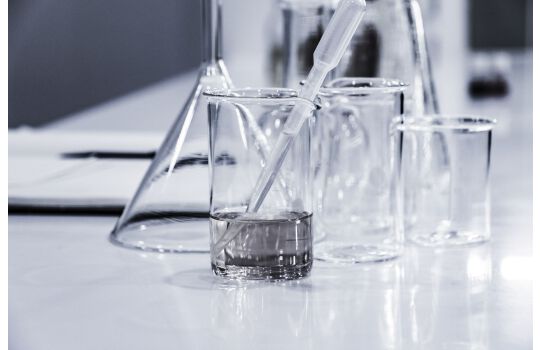Propylene glycol (IUPAC name: propane-1,2-diol) is a synthetic organic compound with the chemical formula C3H8O2. It is a viscous, colorless liquid which is nearly odorless but possesses a faintly sweet taste. Chemically it is classed as a diol and is miscible with a broad range of solvents, including water, acetone, and chloroform.
It is produced on a large scale and is primarily used in the production of polymers, but also sees use in food processing, and as a process fluid in low-temperature heat-exchange applications. In the European Union, it has the E-number E1520 for food applications. For cosmetics and pharmacology, the number is E490. Propylene glycol is also present in propylene glycol alginate which known as E405.
The compound is sometimes called (alpha) α-propylene glycol to distinguish it from the isomer propane-1,3-diol, known as (beta) β-propylene glycol.
Contents
1 Structure and properties
2 Production
2.1 Industrial
2.2 Laboratory
3 Applications
4 Safety in humans
4.1 Oral administration
4.2 Skin, eye and inhalation contact
4.3 Intravenous administration
4.4 Animals
4.5 Allergic reaction
5 Environmental
6 References
7 External links
Structure and properties
Propylene glycol is a clear, colorless and hygroscopic liquid. Propylene glycol contains an asymmetrical carbon atom, so it exists in two enantiomers. The commercial product is a racemic mixture. Pure optical isomers can be obtained by hydration of optically pure propylene oxide.[4]
The freezing point of water is depressed when mixed with propylene glycol, owing to the effects of dissolution of a solute in a solvent (freezing-point depression). In general, glycols are non-corrosive, have very low volatility and very low toxicity; however, the closely related ethylene glycol (a key ingredient in antifreeze) is toxic to humans and to many animals.[5]
Production
Industrial
Industrially, propylene glycol is produced from propylene oxide[6] (for food-grade use), and global capacity in 1990 was 900,000 tonnes per year.[7] Different manufacturers use either non-catalytic high-temperature process at 200 °C (392 °F) to 220 °C (428 °F), or a catalytic method, which proceeds at 150 °C (302 °F) to 180 °C (356 °F) in the presence of ion exchange resin or a small amount of sulfuric acid or alkali.
1,2-Propandiol Synthesis V1.svg
Final products contain 20% propylene glycol, 1.5% of dipropylene glycol and small amounts of other polypropylene glycols.[8] Further purification produces finished industrial grade or USP/JP/EP/BP grade propylene glycol that is typically 99.5% or greater. Propylene glycol can also be converted from glycerol, a biodiesel byproduct. This starting material is usually reserved for industrial use because of the noticeable odor and taste that accompanies the final product


